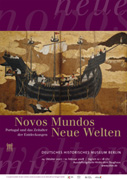


Prologue
| Portugal in the Middle Ages
| Conditions at the Start
| Voyages of Discovery
Cartography and Nautics
| New Worlds – Old Empires
| Portugal Overseas
| Art and Curiosity Cabinets
Portugal in the 16th Century
| International Conflicts
| Foreign Images
In the second half of the 15th century the first Portuguese seamen crossed the equator into the Southern Hemisphere. In 1482 Diogo Cão first reached the mouth of the Congo River and finally, a few years later, Cape Cross in present-day Namibia.
The “great” discoveries then took place during a 30-year period around the turn of the 15th to the 16th century. In 1488 Bartolomeu Dias achieved the longed-for circumvention of the southern tip of Africa, the Cape of Storms, or, as it was finally christened, the Cape of Good Hope. In 1492 Christopher Columbus discovered islands in the western Atlantic. Vasco da Gama reached India in 1498 by way of the sea route around Africa. In 1500 Pedro Álvares Cabral landed on the coast of Brazil. In an expedition led by the Portuguese Gonçalo Coelho, Amerigo Vespucci explored the east coast of Brazil in 1501-1502. He thereupon named the new territories the “New World”. In 1519-1522 Ferdinand Magellan and Juan Sebastián de Elcano succeeded in crossing the Pacific Ocean and completing the first complete circumnavigation of the world.

Vasco da Gama, Portugal,
16. Jahrhundert
Lissabon, Museu Nacional de Arte Antiga

Kolumbusbrief
Brief des Christoph Kolumbus aus der ›Neuen Welt‹ ,
Rom, 1493
Berlin, Deutsches Historisches Museum
